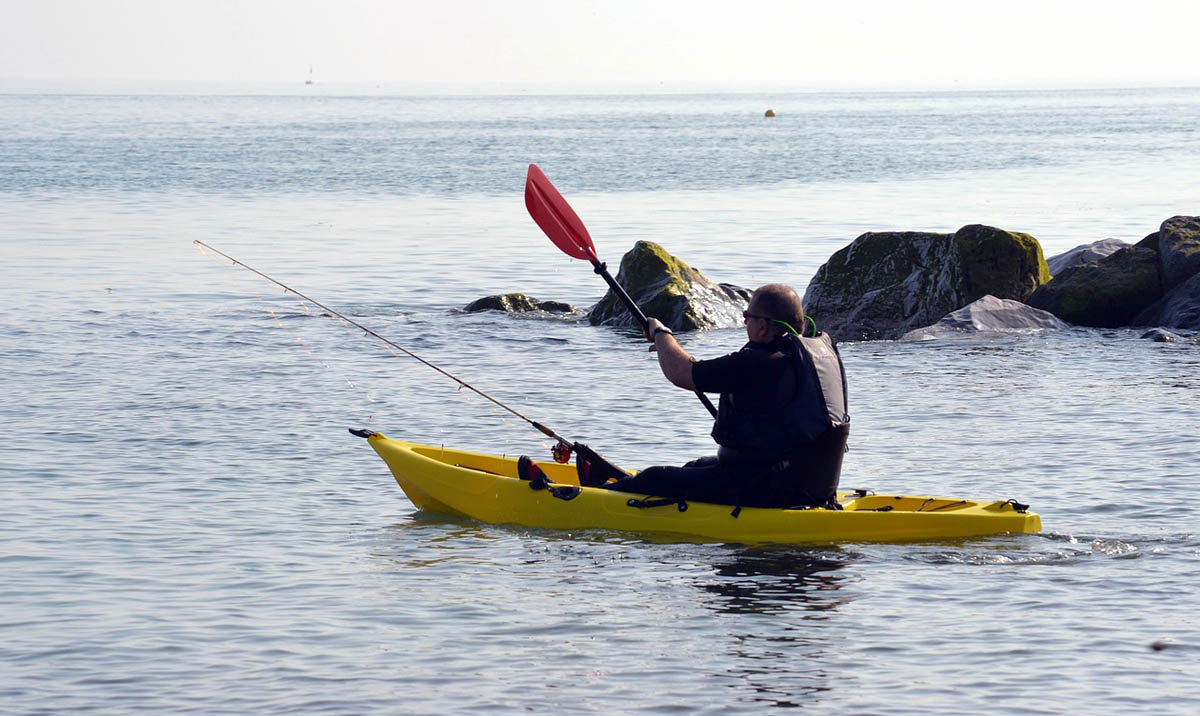By Mike Kogan and Zsolt Takacs
There’s no question that the ultimate big game fish for kayak anglers on the southeastern seaboard is the Tarpon (Megalops atlanticu), a.k.a. the Silver King or Poon. Nothing will get your juices going like being in a thick pogie (menhaden) pod seeing actively feeding tarpon crash through bait, skyrocket, and roll right around the kayak. Catching and releasing a tarpon is not for the beginner kayak fisherman, so take the necessary precautions. The content of this article is the product of advice from a lot of seasoned fishermen and our own experiences.
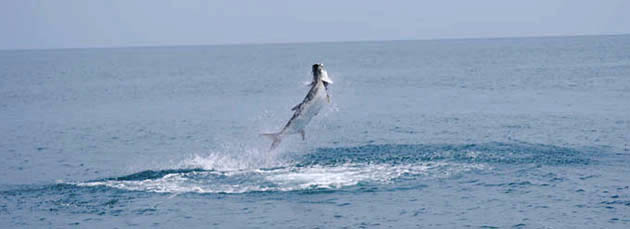
The Silver King! (courtesy Zsolt Takacs)
Since you will be launching in the ocean all the usual ocean safety precautions need to be in effect. Make sure you are properly prepared for a surf launch and recovery, wear a PFD, always fish with at least one partner, have a waterproof floating handheld VHF at hand, and file a float plan. Good polarized sunglasses are a must for spotting pogie pods that are not on the surface flipping.
For rods we use the St. Croix Avid and Premier rods, heavy or extra-heavy action on a 7-8′ rod in the 30lb test weight class. These rods have enough backbone to fight a 100+lb fish and are light enough to throw topwater and magnum-sized artificials. Some of our favorite reels are the Shimano Calcutta 400 or the Penn 525 Mag spooled with 35lb or 50lb braid.
We use two terminal tackle setups on our tarpon rods. The primary one shared by longtime kayak angler Dustin Hill is for pitching live baits or artificials into a bait pod. Start by doubling the braid with a spider hitch, join the doubled braid to 40lb fluorocarbon leader with a uni-to-uni knot, then use a double surgeon’s knot to step up from the 40lb fluorocarbon to 80lb fluorocarbon leader. Tie a Daiichi 14/0 Improved Circle Bleeding Bait Hook onto the end with a palomar knot and you are ready to bait up a live pogie. An alternate setup is to tie a Cajun thunder onto the doubled braid and attach about 3′ of 80lb fluorocarbon leader to the Cajun Thunder. The former rig is for tossing in and down the bait pod and the latter is for floating a pogie closer to the surface. You can also take a float and just clip it onto the first rig rather than using a popping cork rig.
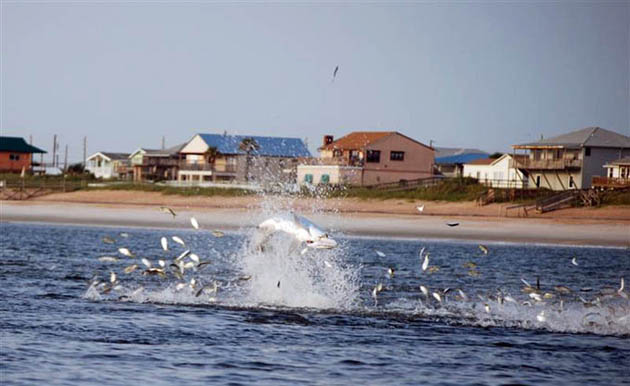
Actively feeding tarpon! (courtesy Zsolt Takacs)
Since you will be fishing in pogie pods with tarpon actively feeding there is no reason to have a live well, bait bucket, or net onboard. Take an inexpensive 6-7ft spinning rod with a size 4 or 6 treble hook tied 6″ from the end, tie a 1oz weight on the bottom, and you have a perfect rig for snatching pogies. Cast the rig into a pod, reel down, and then SNATCH until you get a pogie. Be careful because occasionally a poon will hit that pogie and try to spool your snatch rod, so lock the drag. If a tarpon hits it point the rod at the fish to break him off. Take your pogie from the snatch rod and put him on that big old circle hook through the front of the eye sockets. Now you are ready to fish for a silver king, and have the ride of your life.
Since kayakers can’t cover water like a boat, we use our cars to run the beach searching for pogie pods with tarpon actively feeding in them. High power binoculars are a must and knowing the beach accesses in advance is critical to your plan. Even if you see pogies you need to resist the urge to launch until you see definite signs of tarpon (you’re not alone if you failed this test). Feeding signs are tarpon skyrocketing and jumping out of the air, tarpon rolling through pogie pods, or tarpon blowing through pods of pogies literally knocking hundreds of pogies into the air at a time. While you can launch into any pogie pod and hope tarpon are there or will come, your odds of hooking up are significantly better if you are patient and find a pod with active feeding fish.
Once you launch and get your live pogie ready to go it’s time to cast it into the school of bait. Ideally you want dark balled up pods of bait to fish in rather than thinly dispersed schools. Work the middle and the edges taking car not to go through the center of the pod, although many times the pogies won’t mind you being in the middle. The sound of a kayak paddle is similar to a pogie flipping. Let the bait drift down – actively reeling in the line will prevent the bait from getting down the column. If you are using the float rig just let it drift through the pod – there’s no reason to snap it to rattle the popping cork. The heavier your hook the more the pogie will sink, and the fewer casts it will stay alive. Also make sure you are only fishing one line and start with the drag in a medium to heavy setting. The tighter you go on the drag before the bite the more attuned you must be to the rod so you don’t lose it.
When a tarpon bites it’s like nothing you’ve ever felt – the fish will usually begin a run to the east when it realizes something is amiss and will take line fast. It’s important not to dial up to much drag at this point because the tarpon is on his way to jumping in an attempt to shake the hook. When the fish comes up and out of the water do your best not to just stare in amazement – this is when you need to remember to ease off a hair and “bow to the king” to keep him from shaking the hook free. This is the inaugural stage of the sleigh ride which we’ve seen accelerate a 14′ kayak to 5-6kph in a heartbeat.
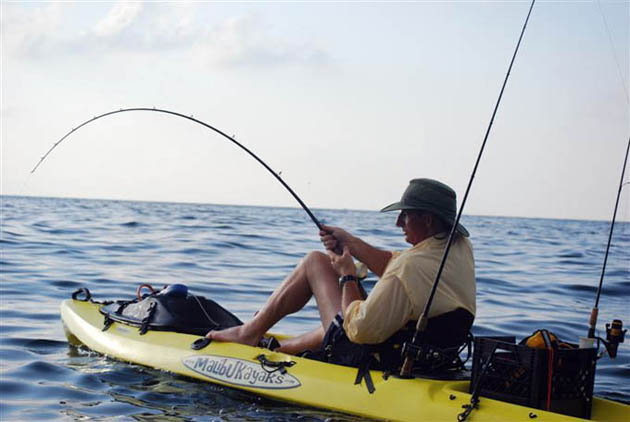
Who caught who? Apply Pressure! (courtesy Zsolt Takacs)
After a couple of jumps most tarpon continue running east for deeper water dragging you along, then sound to the bottom and take the fight vertically. Now the real work starts. Remember if you are not applying pressure and trying to continually turn the tarpon’s head, he is resting; you need to keep the pressure continuous. At this point you can tighten the drag and really use your kayak to make the tarpon work harder. Try and turn the fish’s head and make him fight. Deploying a bucket on a rope, a drag chute, or using your feet in the water will also make the fish work harder. After anywhere from 25 minutes to an hour depending on the size of the fish and the amount of pressure you apply the fish will tire and come up a few times, and will do some last gasp runs before finally tiring. You will know when the tarpon is done because it will literally blow some bubbles and poop. Do NOT attempt to handle a green tarpon.
Now you are ready to get that trophy picture of you with the tarpon – are you ready to stick your hand into that mouth? Having a glove handy will help because by this point you probably have “kung fu grip”, can’t hold onto the reel crank, and your muscles are burning like you been holding a 50lb curling weight for a half hour. Grab the tarpon by the lower jaw, pose for your picture, and thank the fishing gods for hooking you up.
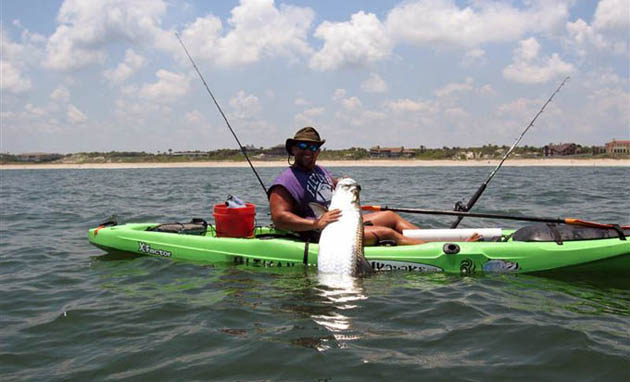
Trophy Pic! (courtesy Mike Kogan)
To release the tarpon use your pliers to remove the hook. If it is difficult because you are too tired or can’t get the proper leverage you can cut the line and remove the hook by pushing the eye through backwards instead of trying to remove its barb first. Make sure you hang on to the tarpon because it is crucial to properly revive that fabulous beast. This will take some time, so having a tow rope that your partner can drag you with is helpful to ensure the survival of the tired fish. Keeping the fish in the water, gently move the fish forward and backward, up and down, to force water through his gills. You’ll know when the fish is ready to go by his movements becoming more forceful, the fish righting himself and trying to swim away. Once he is revived and released, look for the tarpon to swim a couple of yards and come up for a gulp of air, before finally swimming off. Now it’s time for a refreshing drink of water and the “Victory Paddle” as my pal Bali calls the trip back to the pods and your next hookup.
We need a few words about the dangers of kayak fishing for tarpon and etiquette. The most dangerous parts of tarpon fishing are surf launches and offshore concerns and having 100+lb fish in close proximity to your kayak. When launching and landing your kayak in the surf, you need to make sure that all of your gear is securely stowed or tied down to ensure that nothing is lost should there be a wipeout. When kayak fishing for tarpon, it is not uncommon to have the fish so close that while they’re eating they send sea spray over your bow or a few pogies into your yak. It is important that you stay constantly alert, aware, and prepared for the unexpected.
Etiquette when fishing pogie pods can also be a challenge. Motor boats within a ½ mile put out vibrations that will shut down tarpon in a heartbeat, but there is nothing you can do if a boat comes up on the motor, pounds through the pod to get some bait, then leaves. Be patient and often in 15-20 minutes the feeding will resume. If you see someone else already fishing a pod find another one and give those folks some room.
In closing remember that tarpon are a very precious natural resource. They should be revered, respected, and handled with care. Consider that tarpon weighing about 100 pounds typically fall between 13-16 years of age, male tarpon attain life spans of over 30 years, and females may live longer than 50 years. Nothing gets us more fired up than hearing how an angler “battled” a tarpon or went on a sleigh ride for 2 hours – that’s not an epic fight, that’s an angler not putting pressure on the tarpon to end the fight early and literally letting the fish kill itself. Because these fish will fight to the death it is imperative that you take steps to make the fight as short as possible and that you work hard to perform a successful release. If you follow the suggested guidelines, you will get a taste of what so many of us are already enamored with, the love of tarpon!

